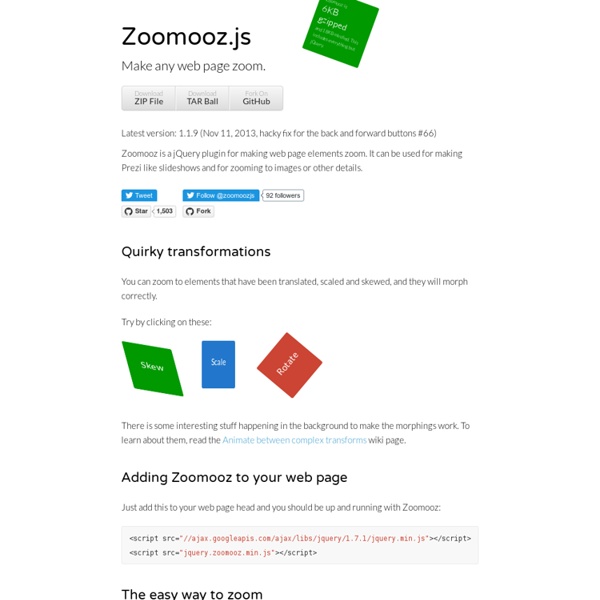HTML5
HTML5 is a markup language used for structuring and presenting content for the World Wide Web and a core technology of the Internet. It is the fifth revision of the HTML standard (created in 1990 and standardized as HTML 4 as of 1997)[2] and, as of December 2012[update], is a candidate recommendation of the World Wide Web Consortium (W3C).[3] Its core aims have been to improve the language with support for the latest multimedia while keeping it easily readable by humans and consistently understood by computers and devices (web browsers, parsers, etc.). HTML5 is intended to subsume not only HTML 4, but also XHTML 1 and DOM Level 2 HTML.[2] History[edit] The Web Hypertext Application Technology Working Group (WHATWG) began work on the new standard in 2004.
Magnifier.js demo
Magnifier.js is a Javascript library enabling magnifying glass effect on an images. Features Zoom in / out functionality using mouse wheel Magnified image can be displayed in the lens itself or outside of it in a wrapper Attachment of user defined functions for thumbnail entering, moving and leaving and image zooming events Display loading text while the large image is loading, and switch to lens once its loaded Magnifier.js uses Event.js as a cross-browser event handling wrapper, which is available at Github and JSClasses.org Works in Chrome, Firefox, Safari, IE 7, 8, 9 & 10. Licensed under the MIT License, © 2013 Mark Rolich
Cascading Style Sheets
CSS is designed primarily to enable the separation of document content from document presentation, including elements such as the layout, colors, and fonts.[1] This separation can improve content accessibility, provide more flexibility and control in the specification of presentation characteristics, enable multiple pages to share formatting, and reduce complexity and repetition in the structural content (such as by allowing for tableless web design). CSS can also allow the same markup page to be presented in different styles for different rendering methods, such as on-screen, in print, by voice (when read out by a speech-based browser or screen reader) and on Braille-based, tactile devices. It can also be used to allow the web page to display differently depending on the screen size or device on which it is being viewed.
api
Setting disable or enable has cascading changes on the select, highlight, and view only when the currently selected item object becomes disabled. An important thing to note here is that “setting” something as enabled or disabled adds the new elements to the collection of items to disable rather than completely replacing them with the new collection. Disable/enable dates § You can disable sets of dates and then enable the entire set or specific dates within those sets by the following methods:
JavaScript
JavaScript is classified as a prototype-based scripting language with dynamic typing and first-class functions. This mix of features makes it a multi-paradigm language, supporting object-oriented,[6] imperative, and functional[1][7] programming styles. JavaScript has been standardized in the ECMAScript language specification.
Microjs: Fantastic Micro-Frameworks and Micro-Libraries for Fun and Profit!
I need ... a base framework. a DOM utility. templating. CSS animation. JavaScript animation.
Stack: Overview
Get Started Now With Typesafe Activator What is a Reactive application? Reactive applications are a new class of applications that are becoming more and more prevalent in both Consumer and Enterprise-facing environments. Reactive applications are fundamentally different to the traditional web-based or mobile applications seen today and are distinguished by having one or more of the following defining traits:
2 - Angular Templates
Loading... Improve this doc Now it's time to make the web page dynamic — with AngularJS. We'll also add a test that verifies the code for the controller we are going to add.



